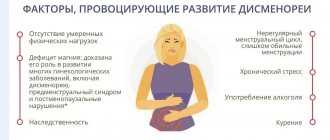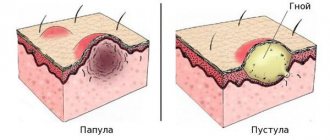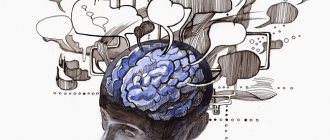Schizophrenic disorders are usually characterized by significant and characteristic distortions of thinking and perception, as well as inappropriate affect. Clear consciousness and intellectual abilities are usually maintained, although there may be some decline in cognitive abilities over time. The most important psychopathological symptoms include the feeling of reflection of thoughts (echo), inserting someone else's or stealing one's own thoughts, transmitting thoughts over a distance; delusional perception and delusion of external control; inertia; auditory hallucinations commenting or discussing the patient in the third person; disordered thoughts and symptoms of negativism.
The course of schizophrenic disorders can be long-term or episodic with progression or stability of disorders; this may be one or more episodes of the disease with complete or incomplete remission. In the presence of extensive depressive or manic symptoms, the diagnosis of schizophrenia should not be made until it is clear that schizophrenic symptoms preceded affective disturbances. Schizophrenia should not be diagnosed in the presence of obvious brain disease, or during drug intoxication or withdrawal. Similar disorders that develop with epilepsy or other brain diseases should be coded under F06.2, and if their occurrence is associated with the use of psychoactive substances, under F10-F19 with a common fourth character of .5.
Excluded:
- schizophrenia: acute (undifferentiated) (F23.2)
- cyclic (F25.2)
Diagnosis F 20.1 Hebephrenic schizophrenia
A form of schizophrenia in which affective changes dominate. Delusions and hallucinations are superficial and fragmentary, behavior is absurd and unpredictable, usually mannerisms. The mood is changeable and inadequate, thinking is disorganized, speech is incoherent. There is a tendency towards social isolation. The prognosis is usually unfavorable due to the rapid increase in “negative” symptoms, especially affective flattening and loss of will. Hebephrenia should only be diagnosed during adolescence and young adulthood.
- Disorganized schizophrenia
- Hebephrenia
Diagnosis F 20.2 Catatonic schizophrenia
The clinical picture of catatonic schizophrenia is dominated by alternating psychomotor disturbances of a polar nature, such as oscillations between hyperkinesis and stupor or automatic submission and negativism. Stiff postures can persist for a long time. A notable feature of the condition may be cases of sudden agitation. Catatonic manifestations can be combined with a dream-like (oneiric) state with vivid stage hallucinations.
Catatonic stupor
Schizophrenic:
- catalepsy
- catatonia
- waxy flexibility
Diagnosis F 20.3 Undifferentiated schizophrenia
A psychotic condition that meets the basic diagnostic criteria for schizophrenia, but does not correspond to any of its forms classified in subheadings F20.0-F20.2, or exhibits features of more than one of the above forms without a clear predominance of a specific set of diagnostic characteristics.
Antitypical schizophrenia
Excluded:
- acute schizophrenia-like psychotic disorder (F23.2)
- chronic undifferentiated schizophrenia (F20.5)
- post-schizophrenic depression (F20.4)
Social adaptation
Dividing children into “special” and “normal” can quickly turn children with mild disabilities into disabled people who become incapable of independent living and require constant care. Such patients live in a fenced-in world, do not communicate with peers, and are unfamiliar with ordinary childhood hobbies and interests. On the other hand, among healthy children the correct attitude towards people with disabilities has not been formed.
Isolating children labeled as “unteachable” in boarding schools and special schools does not improve the situation. Therefore, these outdated traditions are increasingly being replaced by home education in the circle of relatives who are ready to engage in their development and adaptation in society. Parents, with their support, help to get education, treatment, and communication with peers.
When treated correctly, such patients actively interact with others, and they develop an interest in other people and their activities. Using simple, accessible games, the teacher can begin to communicate with the ward and teach him the skills necessary for independent living.
In Western European countries, rehabilitation centers are common, in which patients undergo all stages of adaptation.
In Belgium, one form of such structures is rural communities, in which patients, along with service personnel, participate in organizing life support. They work together in workshops, agriculture, bakeries. In Germany, such communities are common in the form of religious communities. Similar communities have been organized in Russia. In them, patients receive the necessary knowledge, which subsequently contributes to their social adaptation. Mental retardation is a serious and incurable disease, but the caring environment and attentive attitude towards such “special” people will help them find their place in society.
Diagnosis F 20.4 Post-schizophrenic depression
A depressive episode, which can be long-lasting, occurring as a consequence of schizophrenia. Some symptoms of schizophrenia (“positive” or “negative”) may still be present, but they no longer dominate the clinical picture. These depressive conditions are associated with an increased risk of suicide. If the patient no longer shows any symptoms of schizophrenia, a diagnosis of a depressive episode should be made (F32.-). If the symptoms of schizophrenia are still vivid and clear, a diagnosis of the appropriate type of schizophrenia (F20.0-F20.3) should be made.
Causes of the disease
At the end of the 19th century, the German psychiatrist E. Kraepelin proposed the term “oligophrenia” to designate the entire category of congenital or acquired bewilderment. This name is still used today.
The causes of the pathology are varied.
All factors that cause UO can be hereditary or predetermined by external influences. The latter is an effect on the developing fetus through the body of a pregnant mother or damage to the brain of a baby under the age of three.
Mental retardation often accompanies deviations of individual organs and systems. They are so typical that they can be used to make a diagnosis even before mental retardation manifests itself.
In addition, it is possible to combine the influence of these factors. There are now more than 300 different hereditary diseases known, which include severe mental retardation. Among those associated with oligophrenia are Down and Marfan syndrome and other diseases.
syndrome refers to mental retardation caused by chromosomal abnormalities - the presence of an extra 21 chromosome. The incidence of the disease among newborns ranges from 1:600 to 1:900. It has been established that the older the mother, the greater the risk of having a child with this pathology.
Children suffering from this pathology:
- short stature;
- with short arms and legs, disproportionate to the length of the body, short fingers, with the thumb placed low and the little finger curved;
- large skull;
- the upper jaw is often underdeveloped, the lower jaw is advanced;
- small deformed ears;
- sparse dry hair on the head.
For diagnosis, atypically located folds on the palms, as well as an altered fingerprint pattern, are of great importance. The reproductive organs and secondary sexual characteristics are also underdeveloped.
The more severe the disease, the faster it is detected. Already in infancy, mental retardation becomes noticeable. Such children later begin to walk and talk, but their speech remains undeveloped and limited. Patients are not endowed with childlike curiosity; it is difficult for them to understand the content of simple children's activities and games. The mental development of such children is inhibited.
Diagnosis F 20.5 Residual schizophrenia
A chronic stage in the development of the disease of schizophrenia in which there has been a clear transition from an early stage to a late stage, characterized by long-term (though not necessarily irreversible) “negative” symptoms such as psychomotor retardation; low activity; emotional dullness; passivity and lack of initiative; poverty of speech content; poverty of nonverbal interactions through facial expressions, eye expression, intonation and posture; decreased self-care and paucity of social activities.
Chronic undifferentiated schizophrenia
Residual schizophrenic state
Clinical forms of mental retardation
The classification of oligophrenia in practice is based on the main clinical sign of the disease - mental retardation. The severity of the disease has four degrees and is indicated in the ICD by codes:
- light – F70;
- moderate – F71;
- heavy – F72;
- deep – F73.
The human psyche is an area of continuous study and research. Sometimes it can be difficult to make an accurate diagnosis of the disease and relate it to a certain degree. Therefore, the ICD classification of mental retardation also includes other forms of mental retardation (F78). If there is difficulty or impossibility of diagnosis, for example, due to the patient’s blindness or deafness, unspecified (F79).
Mild degree
To quantify the degree of the disease, the intellectual development coefficient (IQ) is used. Thus, mild mental retardation is manifested by an approximate IQ level of 50-69 and corresponds to the development of a person aged 9–12 years.
This form of pathology is the most common and has many variants of manifestation.
Mild mental retardation can vary from almost normal, that is, at the level of mentally healthy people with a low IQ level, to more severe manifestations. Thus, there is significant heterogeneity in clinical indications, differences in the pace of mental development, as well as different severity of mental disorders observed in patients as they gain life experience.
A change in the usual life pattern leads to the manifestation of a mild degree of MR in a later period. Most patients finish incomplete secondary school. Mental retardation manifests itself when such patients try to continue their education or undergo a medical examination in connection with military service, registration for work, as well as during a forensic psychiatric examination.
Such patients have well-developed speech, quite adequate behavior and independence in their lifestyle. Weakness of thinking is masked by a good ability to imitate and mechanical memory.
Identification of patients with mild mental retardation requires careful research using special methods. They reveal such manifestations of pathology as difficulty in the transition from simple generalizations to more complex ones, from sensory cognition to abstract thinking.
Despite the general underdevelopment of the psyche, patients retain their individuality. They have their own character, social habits, and have their own personality traits.
Extreme manifestations of pathology:
- swagger;
- excessive mobility;
- excitement;
- conflict;
- importunity;
- hypersexuality.
The other extreme is also possible:
- lethargy;
- lethargy;
- apathy;
- indifference to everything around.
Most often, average indicators of these manifestations are present, and only some cases of characterological features indicate the presence of pathology.
The common characteristic of such patients is the inability to experience higher emotions; they have no need to understand the environment. They may show interest, but at the same time they do not gravitate towards studying and understanding reality. The volitional sphere of patients combines weakness of initiative with excessive impulsiveness of behavior. They are highly suggestible, prone to imitation, and very stubborn.
Mild mental retardation gives patients weak self-control and low ability to restrain their impulses, insufficient holistic thinking of actions, but at the same time, under the influence of a change in the situation, they can adjust behavior and foresee the possible consequences of actions.
It is worth noting that the increased suggestibility and tendency to imitate such patients works positively when the socio-psychological climate in which the patient is located changes.
Therefore, if he is in unfavorable conditions, then mental retardation worsens and leads to antisocial phenomena: reluctance to work, disregard for generally accepted norms of behavior. Such patients abuse alcohol, can become drug addicts, commit thefts and other acts that violate the law.
Moderate degree
Moderate mental retardation appears earlier than its mild form. The IQ level of patients corresponds to 20–50. Such children attend school, but already at the very beginning of their education their inability to master even easy educational material becomes apparent.
Conventional pedagogical methods do not improve academic performance, and such students are transferred to specialized boarding schools after grades 2–4. Such training uses special techniques that help patients learn to read, count and write. Some children can master more complex cognitive skills.
During training, the underdevelopment of abstract thinking becomes visible. Patients are limited to the external signs of objects and phenomena; they cannot realize the hidden meaning of metaphors, sayings and proverbs. They lack the construction of logical chains, which leads to mechanical learning of material and blind imitation.
Moderate mental retardation has common characteristic features:
- weakness of focused attention;
- poor fixation on the subject of study;
- rapid distraction of attention;
- passive attention without understanding the surrounding reality;
- poor vocabulary;
- incorrect semantic use of words;
- predominance of speech cliches;
- primitive short phrases.
However, auxiliary school students are often taught simple production skills that involve mechanical, stereotypical work. Upon completion of training, they successfully work in production at psychiatric institutions or in ordinary conditions.
The difficulty of patients’ adaptation in society lies in the need to adapt to a changing environment, which does not correspond to already established patterns of behavior and requires not only comprehension skills, but sometimes also creative solutions to new problems and challenges.
Severe mental retardation
The form of the most profound congenital dementia is determined by the main indicator of intelligence IQ at a level of less than 20. Mental functions in such patients are almost completely absent.
Immediately after birth, sick babies show signs of a brain defect: sharply increased or decreased head size, as well as pathologies of internal organs.
Due to the severe consequences of intrauterine development disorders, such children rarely live more than 20 years. They fail to master even the most basic life skills. Reactions to the environment are weakened, significantly distorted or completely absent.
Severe mental retardation manifests itself in:
- inability to move independently;
- lack of fixed attention;
- learning disabilities;
- poor coordination of movements;
- failure to comply with hygiene rules;
- lack of expressive speech;
- misunderstanding the meaning of words;
- immobility or stereotypical movements;
- spontaneous excitement.
Patients with severe oligophrenia do not realize their inferiority, remain helpless and require constant care.
Although patients do not understand the speech addressed to them and do not grasp the meaning of the words, they sometimes correctly respond to intonation, which makes it possible to interact. This is especially important in the work of staff in specialized institutions.
During attacks of unmotivated agitation, patients with their chaotic movements can cause bodily harm to the supervising personnel, although they do not cause significant damage.









